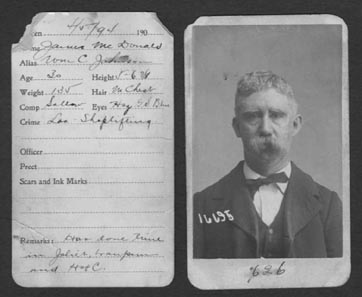In my next to final
essay, "Discipline and Photograph . . . ," I further assimilate Giddens's
thinking to my own project, a study of the representation of prison and
prisoners, noting that becoming social is not viewed in monological terms
asserting the primacy of either the agent or structure but on the cognitive
level, as notes Giddens ". . . mastery of the 'dialogical' contexts
of communication. Such mastery is by no means wholly discursive, but involves
the accumulation of practical knowledge of the conventions drawn upon in
the production and reproduction of social interaction'." Thus, this inquiry
into Danny Lyon's and Morrie Camhi's photobooks, and Gary Glassman/Jonathan
Borofsky's and Stephen Roszell's video tapes assumes that the carceral regime
is a discursive space that exists through the actions and interactions of
its participants in and out of prison.

Stills
from Glassman/Borofsky's
videotape
Prisoners (1990)
"Meaning-worlds"
are produced which reflect the ongoing, lived experience of the various
people caught up within the discursive regime that is the penitentiary:
inmates, guards, and their families, the prison administration, reformers,
and revolutionaries. These carceral meaningworlds are produced/reproduced
in the various representations of the prison, prisoners, and staff. The
four texts under scrutiny are examined not as simply embodying, as Fredric
Jameson put it, "some commonsense external reality," but as "always be[ing]
(re)constructed after the fact."

Cartes-de-visites
mugshot card, anonymous (1899)
As my discussion
moves to its conclusion, I address, borrowing from insights by Jurij Lotman,
the relationship between the person who initiates the carceral investigation,
the inmate, and the prison that constrains him/her as embodied in the mutual
implication of agent and structure:
"The
[carceral] investigator (male or female) crosses the boundary, 'penetrates'
the inside-space (the cellblock, coded as 'female,' resistant to transformation,
a topos, a matrix) and, hence, is always positioned as 'male' (the active
principle culture, the creator of differences and norms) by the narrative
structure. Even when the inmate seems to actively resist that inside-space,
as does Billy George McCune [Lyon's version of Sartre's 'Saint Genet'],
such resistance is always linked to the mobile character (Lyon in this
instance) who functions as the exchange mechanism between inside and outside.
Thus, the female position in these narratives is fixed by the mythical
mechanism, creating distinctions, the primary one being sexual difference.
A product of this coding of the carceral as 'female' which, in turn,
refortifies patriarchal master discourse is the belief that once inside
prison one is impotent to affect the direction of one's life (structure
usurps agency): one is subject to rape and is figuratively (literally in
McCune's case) castrated."
One recalls Adorno's
observation in Negative Dialectics (1973): "In the age of the concentration
camp, castration is more characteristic of social reality than competitiveness."
As the essay develops, I further discuss the agency/structure debate in
terms of repressive, honorific, and ironic representations of the carceral
subject, detailing both 19th-century and recent instances of these functions
of representation. In this context it is again pertinent to cite Adorno's
Negative Dialectics "To use the strength of the subject to break
through the fallacy of constitutive subjectivity " for his words seem
to shadow Giddens's notion of the duality of structure and address the
theme of my investigation of the carceral. Martin Jay, discussing Adorno's
thinking on this issue, cites from the "Introduction" to the latter's The
Positivist Dispute in German Sociology (1976):
"Although
society has a subjective side because it always refers back to human beings,
it 'is objective because, on account of its underlying structure, it cannot
perceive its own subjectivity, because it does not possess a total subject
and through its organization it thwarts the installation of such a subject.'
Not only was a meta-subject lacking, so too was the individual subjectivity
that might account for society on consensual, social contractual lines.
Social nominalism of this type was no less ideological than the rigorous
social realism that denied any role to individuals whatsoever."
This discussion
of agency and structure attempts to read their relationship as more complex
than a simple binary opposition through an overcoming of an either/or logic
with a both/and model which I see as closely figuring Jacques Derrida's
"logic of the supplement" which overturns all such oppositional logic.
This essay, drawn from prefatory and introductory remarks to a lengthier
study of the carceral regime, functions here to introduce, to provide a
background for, my concluding essay which further develops the subversion
of such simple antinomies by drawing upon Derrida's logic of the supplement
and applying it to a specific body of artwork.
"
'La Pinta: An Incredible Topology' furthers my discussion of carceral narratives.
It is an attempt to think beyond Lotman's static structuralist binarism
of in/out, as sketched out in the previous essay, using Jacques Derrida's
fluid Deconstructionist subversion of this foundational dichotomy via the
"marginal graft," a particular instance of his logic of the supplement.
The theoretical implications so developed are applied to an explication
of New Mexican photographer Bob Saltzman's photographer-inmate collaborations
in which the image-maker's color portraits of the inmates in New Mexico's
State Penitentiary at Santa Fe are enframed, marginally glossed, supplemented
by ink drawings the inmates so pictured have rendered. Saltzman's collaborations
produce a sense of repeated transgressions between prisoner-created frame
(what Derrida terms the parergon) and Saltzman's centrally-placed
photograph (ergon). Saltzman's collaborative photoworks, "La Pinta:
Doing Time in Santa Fe," intuitively subvert the binary topology necessary
for the kind of structural domestication discovered by Lotman: Their subversiveness
can be figured as implementing a Derridean deconstructionist double-play
called 'the logic of the supplement' which displaces the rigidity of oppositions
such as inside/outside, center/ margin, image/frame. Jacques Derrida rethinks
interiority by investigating how the effect of discursive space is produced
and how that space makes possible an institution, founds an 'architecture'
in which 'topology poses the [phallogocentric] law,' repressing the play
of difference with a violence it seeks to hide through domestication, through
the construction of the prison-house."
Derrida, thus,
examines the production of inside and outside in itself, finding something
even more subtle (it seeks to hide), more primary (the opposition between
inside and outside is the matrix for all possible oppositions, such as
the agency/structure opposition), and more violent (an irruptive force)
than Lotman's static structuralist formulation. The Saltzman-inmate collaborations
figure Derrida's simultaneous "double-play" of deconstruction as an oscillation
between two rebellious gestures toward the "architecture" (understood as
both discursive and physical) of the prison-house: the first, an escape
attempt without changing terrain, uses against this carceral edifice the
instruments or stones already available in the prison-house; the second,
an absolute break, asserts difference by irruptively attempting to displace
the inmates from their carceral confines. The result? A revelation that
the prison-house, the carceral regime, is founded upon a discursive abyss,
but so founded as to hide that abyss, to prevent the discovery that it
is not unshakable. Saltzman's collaborations figure that abyss. Although
the final two essays of this anthology explicitly examine structure and
agency within the context of the carceral, the attempt to conceptualize
them beyond a simple binarism so as to reveal the fragility of all architectures
of thought underlies each and every essay herein.
James R. Hugunin,
Chicago, IL


